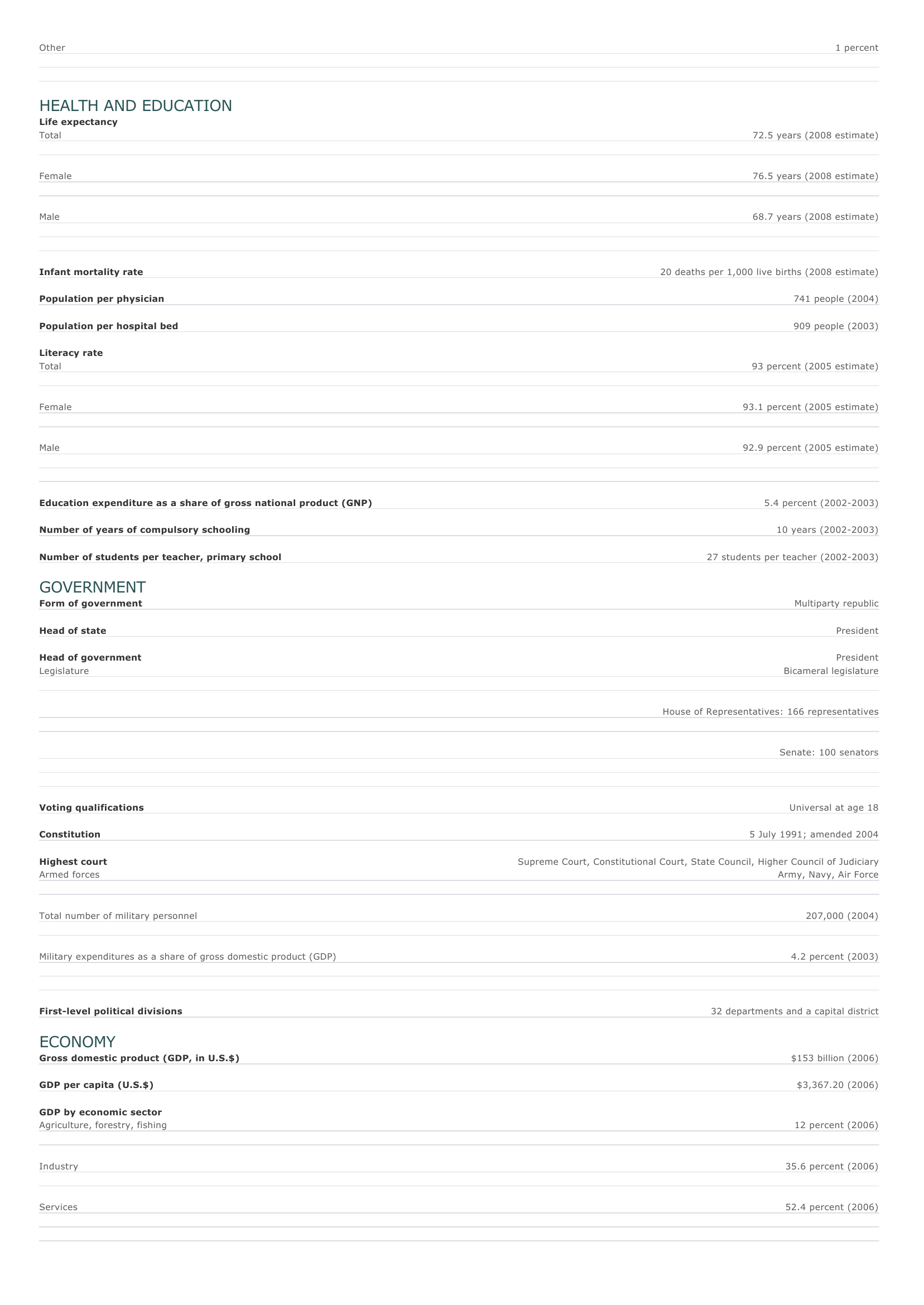Colombia Facts and Figures. BASIC FACTS Official name Capital Area Republic of Colombia Bogotá 1,141,748 sq km 440,831 sq mi PEOPLE Population 45,013,674 (2008 estimate) Population growth Population growth rate 1.41 percent (2008 estimate) Projected population in 2025 55,270,899 (2025 estimate) Projected population in 2050 64,977,344 (2050 estimate) Population density 43 persons per sq km (2008 estimate) 112 persons per sq mi (2008 estimate) Urban/rural distribution Share urban 77 percent (2005 estimate) Share rural 23 percent (2005 estimate) Largest cities, with population Bogotá 6,778,691 (2005) Cali 2,075,380 (2005) Medellín 2,223,660 (2005) Barranquilla 1,113,016 (2005) Cartagena 895,400 (2005) Ethnic groups Mestizo 58 percent White 20 percent Mulatto (people of mixed black and white ancestry) 14 percent Black 4 percent Mixed black-Native American 3 percent Native American 1 percent Languages Religious affiliations Roman Catholic Spanish (official) 96 percent Protestant 2 Percent Nonreligious 1 percent O ther 1 percent HEALTH AND EDUCATION Life expectancy Total 72.5 years (2008 estimate) Female 76.5 years (2008 estimate) Male 68.7 years (2008 estimate) Infant mortality rate 20 deaths per 1,000 live births (2008 estimate) Population per physician 741 people (2004) Population per hospital bed 909 people (2003) Literacy rate Total 93 percent (2005 estimate) Female 93.1 percent (2005 estimate) Male 92.9 percent (2005 estimate) Education expenditure as a share of gross national product (GNP) Number of years of compulsory schooling Number of students per teacher, primary school 5.4 percent (2002-2003) 10 years (2002-2003) 27 students per teacher (2002-2003) GOVERNMENT Form of government Head of state Head of government Legislature Multiparty republic President President Bicameral legislature House of Representatives: 166 representatives Senate: 100 senators Voting qualifications Constitution Highest court Armed forces Total number of military personnel Military expenditures as a share of gross domestic product (GDP) First-level political divisions Universal at age 18 5 July 1991; amended 2004 Supreme Court, Constitutional Court, State Council, Higher Council of Judiciary Army, Navy, Air Force 207,000 (2004) 4.2 percent (2003) 32 departments and a capital district ECONOMY Gross domestic product (GDP, in U.S.$) GDP per capita (U.S.$) $153 billion (2006) $3,367.20 (2006) GDP by economic sector Agriculture, forestry, fishing 12 percent (2006) I ndustry 35.6 percent (2006) Services 52.4 percent (2006) Employment Number of workers 22,771,433 (2006) Workforce share of economic sector Agriculture, forestry, fishing 22 percent (2005) I ndustry 19 percent (2005) Services 59 percent (2005) Unemployment rate 13.7 percent (2004) National budget (U.S.$) Total revenue $35,361 million (2006) Total expenditure $39,065 million (2006) Monetary unit 1 Colombian peso (Col$), consisting of 100 centavos Agriculture Coffee, cacao beans, sugarcane, bananas, tobacco, cotton, cut flowers, rice, potatoes, cassava, plantains Mining Petroleum, natural gas, coal, nickel, emeralds, gold Manufacturing Food products, textiles, beverages, chemical products, transportation equipment Major exports Coffee, agricultural products (especially bananas, flowers, and cotton), petroleum, coal, gold, emeralds, chemicals, textiles Major imports Machinery and transportation equipment, chemicals, minerals, metals, food Major trade partners for exports United States, Venezuela, Ecuador, Germany, and United Kingdom Major trade partners for imports United States, Venezuela, Mexico, Brazil, and Germany ENERGY, COMMUNICATIONS, AND TRANSPORTATION Electricity production Electricity from thermal sources 23.39 percent (2003 estimate) Electricity from hydroelectric sources 75.52 percent (2003 estimate) Electricity from nuclear sources Electricity from geothermal, solar, and wind sources Number of radios per 1,000 people 0 percent (2003 estimate) 1.09 percent (2003 estimate) 575 (2000 estimate) Number of telephones per 1,000 people 168 (2005) Number of televisions per 1,000 people 298 (2000 estimate) Number of Internet hosts per 10,000 people 26 (2003) Daily newspaper circulation per 1,000 people 49 (1996) Number of motor vehicles per 1,000 people 51 (1999) Paved road as a share of total roads SOURCES 14 percent (1999) Basic Facts and People sections Area data are from the statistical bureaus of individual countries. Population, population growth rate, and population projections are from the United States Census Bureau, International Programs Center, International Data Base (IDB) (www.census.gov). Urban and rural population data are from the Food and Agriculture Organization (FAO) of the United Nations (UN), FAOSTAT database (www.fao.org). Largest cities population data and political divisions data are from the statistical bureaus of individual countries. Ethnic divisions and religion data are largely from the latest Central Intelligence Agency (CIA) World Factbook and from various country censuses and reports. Language data are largely from the Ethnologue, Languages of the World, Summer Institute of Linguistics International (www.sil.org). Health and Education section Life expectancy and infant mortality data are from the United States Census Bureau, International Programs Center, International database (IDB) (www.census.gov). Population per physician and population per hospital bed data are from the World Health Organization (WHO) (www.who.int). Education data are from the United Nations Educational, Scientific and Cultural Organization (UNESCO) database (www.unesco.org). Government section Government, independence, legislature, constitution, highest court, and voting qualifications data are largely from various government Web sites, the latest Europa World Yearbook, and the latest Central Intelligence Agency (CIA) World Factbook. The armed forces data is from Military Balance. Economy section Gross domestic product (GDP), GDP per capita, GDP by economic sectors, employment, and national budget data are from the World Bank database (www.worldbank.org). Monetary unit, agriculture, mining, manufacturing, exports, imports, and major trade partner information is from the statistical bureaus of individual countries, latest Europa World Yearbook, and various United Nations and International Monetary Fund (IMF) publications. Energy, Communication, and Transportation section Electricity information is from the Energy Information Administration (EIA) database (www.eia.doe.gov). Radio, telephone, television, and newspaper information is from the United Nations Educational, Scientific and Cultural Organization (UNESCO) database (www.unesco.org). Internet hosts, motor vehicles, and road data are from the World Bank database (www.worldbank.org). Note Figures may not total 100 percent due to rounding. Microsoft ® Encarta ® 2009. © 1993-2008 Microsoft Corporation. All rights reserved.

































